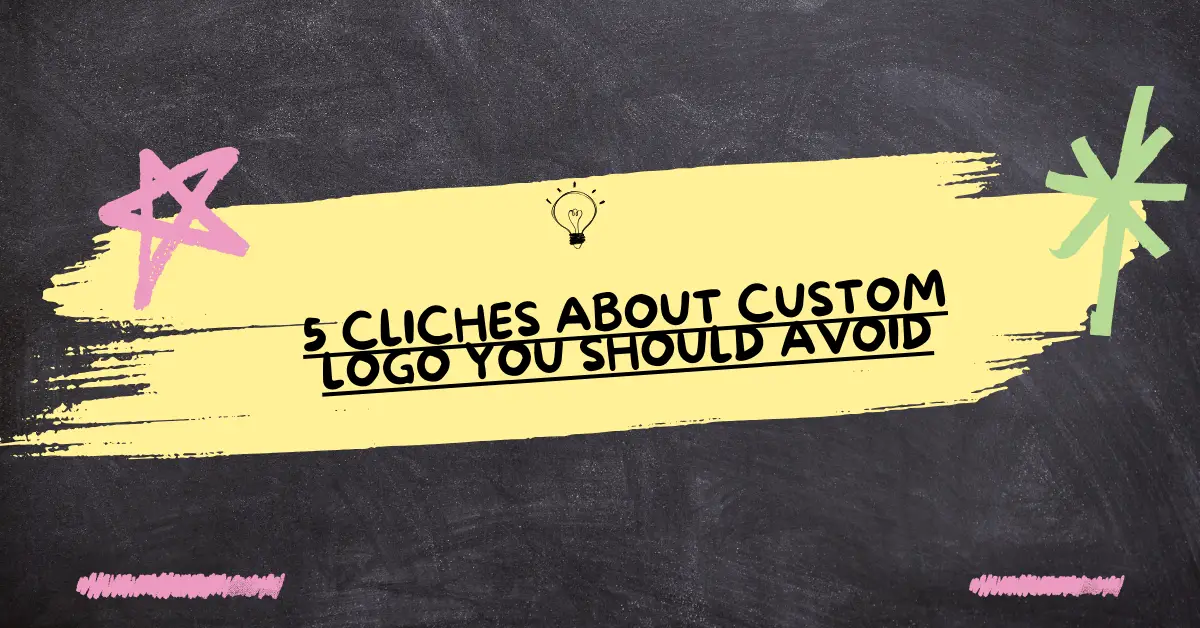Introduction
A custom logo design helps build a strong first impression. In the world of design, clichés are the enemy of creativity. They undermine originality, dilute a brand’s identity, and fail to make a lasting impression. When it comes to custom logos, clichés are especially dangerous because a logo is often the first point of interaction between a brand and its audience. Avoiding overused design elements is crucial for creating a logo that stands out in a crowded marketplace.
Here are five clichés about custom logos you should steer clear of, along with insights on how to approach design differently to ensure your logo is unique and impactful.
1. The Overuse of Generic Icons
Cliché:
Incorporating overused icons like globes, lightbulbs, or generic leaves.
Generic icons have been used so frequently that they’ve lost their originality and meaning. A globe, for instance, is often associated with “global reach” or “connectivity,” but it has become such a default choice that it fails to make an impression.
Why to Avoid It:
- They lack specificity and fail to communicate what makes your brand unique.
- These icons are common in stock libraries, making your logo indistinguishable from countless others.
Alternative Approach:
Choose symbols or graphics that reflect your brand’s unique story, industry, or values. Instead of a generic leaf, a sustainable business might use a custom-drawn plant that symbolizes its commitment to local ecosystems.
2. Relying on Trendy Design Styles
Cliché:
Following fleeting design trends like gradient overload, flat minimalism, or geometric sans-serif typography.
Trends can give your logo a contemporary feel, but relying solely on them risks making your logo look outdated as soon as the trend fades. For instance, logos with excessive gradients were all the rage a few years ago, but many now seem dated and lack adaptability across mediums.
Why to Avoid It:
- Trends are short-lived and don’t guarantee timelessness.
- They can overshadow the core message of your brand.
Alternative Approach:
Focus on timeless design principles: simplicity, balance, and relevance. Incorporate trends subtly without making them the central feature of your logo.
3. Using Too Many Colors or Fonts
Cliché:
Overloading the logo with a rainbow of colors or mixing multiple fonts.
A logo with too many colors or fonts looks cluttered and confusing. It can overwhelm the viewer and fail to convey a clear brand message. For example, combining script fonts with bold block fonts and adding vibrant colors creates visual chaos.
Why to Avoid It:
- It reduces readability and aesthetic appeal.
- Too many elements make the logo hard to reproduce in black-and-white formats.
Alternative Approach:
Limit your color palette to two or three harmonious shades and choose one primary font. This creates a clean, cohesive design that’s easy to recognize and reproduce across various platforms.
4. Copying Competitors’ Logos
Cliché:
Mimicking the style or elements of a successful competitor’s logo.
While it’s tempting to borrow inspiration from industry leaders, doing so erases your brand’s identity and invites legal and ethical issues. For instance, a tech startup creating a logo similar to Apple’s might seem clever at first, but it communicates a lack of originality.
Why to Avoid It:
- It undermines your brand’s credibility.
- Customers may confuse your brand with competitors, leading to loss of trust.
Alternative Approach:
Conduct thorough competitor analysis to understand the market while identifying gaps you can fill. Focus on what makes your brand different and highlight those elements in your logo design.
5. Overloading the Logo with Meaning
Cliché:
Trying to incorporate every aspect of the brand’s identity into one logo.
Some businesses want their logo to reflect their mission, vision, values, and every service they offer. The result is often a cluttered and overly complicated design that fails to make an impact.
Why to Avoid It:
- Complexity makes logos less memorable.
- Overloading the design reduces its scalability and readability.
Alternative Approach:
Adopt the “less is more” philosophy. Focus on one or two key messages your logo should convey. A clean and simple design can communicate your brand’s essence far more effectively than an overly complex one.
How to Create a Unique and Effective Logo
Now that you know what to avoid, let’s look at how to create a logo that stands out.
1. Research Your Audience
Understanding your target audience’s preferences and values can guide your design decisions. For instance, younger audiences might prefer modern and bold designs, while older demographics may value tradition and elegance.
2. Highlight Your USP
Your logo should reflect your Unique Selling Proposition (USP). Whether it’s innovation, quality, or customer service, ensure your design aligns with your brand’s strengths.
3. Work with a Professional Designer
Hiring a skilled designer ensures your logo is crafted with expertise. They can help you avoid clichés and create a design tailored to your brand’s needs.
4. Test Your Logo Across Mediums
A good logo should look great in various formats, from digital screens to print. Test it on different platforms to ensure scalability and versatility.
FAQs About Custom Logos
1. Why should I avoid generic icons in my logo?
Generic icons fail to set your brand apart and may confuse your audience. A custom icon, on the other hand, communicates uniqueness and builds stronger brand recognition.
2. What makes a logo timeless?
A timeless logo uses simple, well-balanced elements and avoids relying on fleeting design trends. Its design remains relevant across decades and appeals to a wide audience.
3. Can I include multiple fonts in my logo?
While it’s possible, it’s best to limit your design to one or two complementary fonts to ensure clarity and consistency.
4. How many colors should a logo have?
Ideally, a logo should have 2-3 colors. This keeps the design clean and makes it easier to reproduce across different mediums.
5. Is it okay to take inspiration from competitors?
Drawing inspiration is fine, but outright copying is not. Your logo should be unique and reflect what sets your brand apart from competitors.
6. How can I make my logo scalable?
Design your logo in vector format, which allows it to be resized without losing quality. Avoid using intricate details that may blur when scaled down.
7. Why is simplicity important in logo design?
A simple logo is easier to recognize, recall, and reproduce. It also ensures your message isn’t lost in unnecessary complexity.
8. Can I redesign my logo if it feels outdated?
Yes, a logo refresh can modernize your brand. Just ensure the redesign retains core elements that existing customers associate with your brand.
9. Should I trademark my custom logo?
Trademarking your logo protects your intellectual property, ensuring no one else can use or copy your design.
10. How do I avoid clichés in my logo design?
Work with a professional designer, conduct thorough research, and focus on your brand’s unique story and values instead of relying on overused design elements.
Conclusion
Avoiding clichés in custom logo design is crucial for creating a distinctive and impactful brand identity. By steering clear of generic icons, fleeting trends, and overly complicated designs, you can craft a logo that stands the test of time and effectively communicates your brand’s essence. Remember, a well-designed custom logo is an investment in your brand’s future. Make it count!


